A Burrata Caprese salad is so easy and takes only about 10 minutes to make. This delicious dish uses fresh basil, ripe, juicy tomatoes and creamy, silky burrata cheese to create a simple, elegant and monumentally flavorful salad. See my variations for a dairy-free version!

Jump to:
- Why you’ll love this recipe
- What is burrata?
- What does burrata cheese taste like?
- Burrata vs mozzarella – what’s the difference?
- Is caprese salad healthy?
- Ingredients
- Instructions
- How to make a balsamic reduction
- Expert tips
- Burrata cheese substitute
- How to serve
- How to store
- Variations
- FAQ
- What to serve with burrata caprese
- 📖 Recipe
- 💬 Comments
Making a burrata cheese caprese salad is so incredibly simple and creates a beautiful, vibrant dish that's impressive and absolutely delicious. Serving a caprese salad with burrata instead of regular mozzarella is a delightful twist on a traditional caprese recipe. It adds complexity and a luxurious mixture of curds and cream, creating a savory, velvety and refreshing salad with a big wow factor.
While this is often served as a summer salad, it can be enjoyed any time of year and pairs perfectly with everything from tender Smoked Sirloin to an easy, juicy Oven Roasted Chicken.
Why you’ll love this recipe
- Outstanding flavor – the combination of aromatic basil, creamy cheese and acidic tomatoes are a delight for the senses
- Fast and Easy – this is one of the easiest salads to put together and takes only about 10 minutes
- Healthy – it's a beautiful salad packed with vitamins, minerals, omega-3 fatty acids and antioxidants
- Special diet friendly – this dish is low-carb keto and FODMAP-friendly. It can also be made with cashew cheese for a vegan, paleo and Whole30 salad.
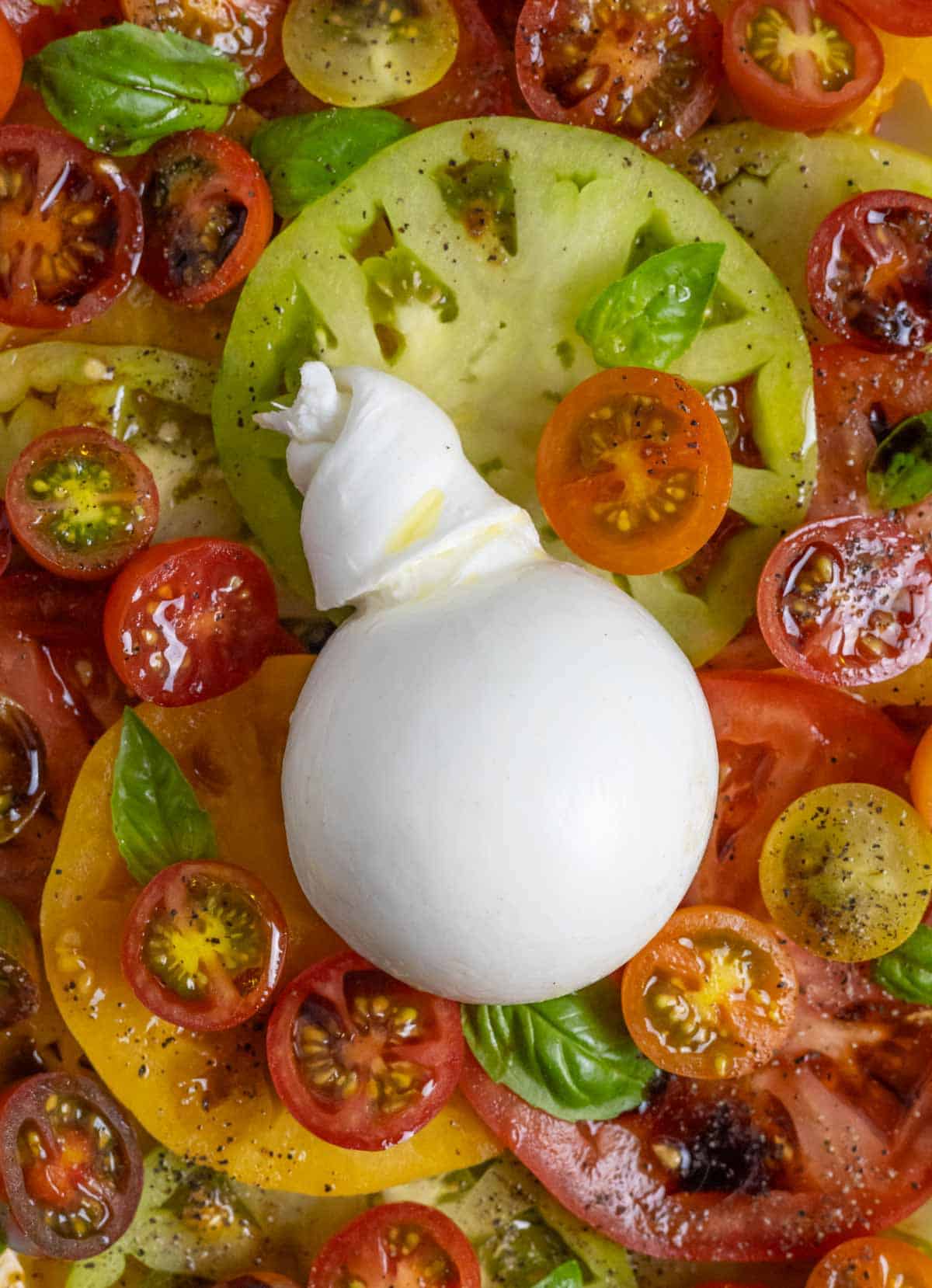
What is burrata?
Burrata is a soft, mild, fresh Italian cheese with a firm outer layer and creamy, velvety interior. It's filled with ‘stracciatella’, a combination of cream and shredded mozzarella and is made from either cow or water buffalo milk.
What does burrata cheese taste like?
It has a buttery, rich, slightly sweet flavor with a just a hint of salt, umami and tanginess. It’s luscious and creamy and almost dissolves on the palate.
Flavor greatly depends on the quality of the ingredients that go into the burrata. The most flavorful cheese will be made with the highest quality milk and cream and will contain only 6 ingredients: milk, salt, rennet, cultures, cream and stracciatella.
Burrata vs mozzarella – what’s the difference?
While both are creamy, Italian cheeses, there are a few major differences between the two. Mozzarella is sliceable, chewy with a bit of elasticity and solidly holds its shape when sliced. Burrata is a ball made from mozzarella, with a firm, edible outer casing and a creamy, spreadable interior. When sliced, it does not hold its shape, revealing its creamy, soft contents.
Is caprese salad healthy?
Yes! It’s made with fresh ingredients that are packed with nutrition. Tomatoes are rich in vitamins A, C, and K, and lycopene that may benefit heart and eye health. Mozzarella is rich in calcium and protein and olive oil is rich in healthy fats. Basil contains vitamins and antioxidants and may have anti-inflammatory properties.
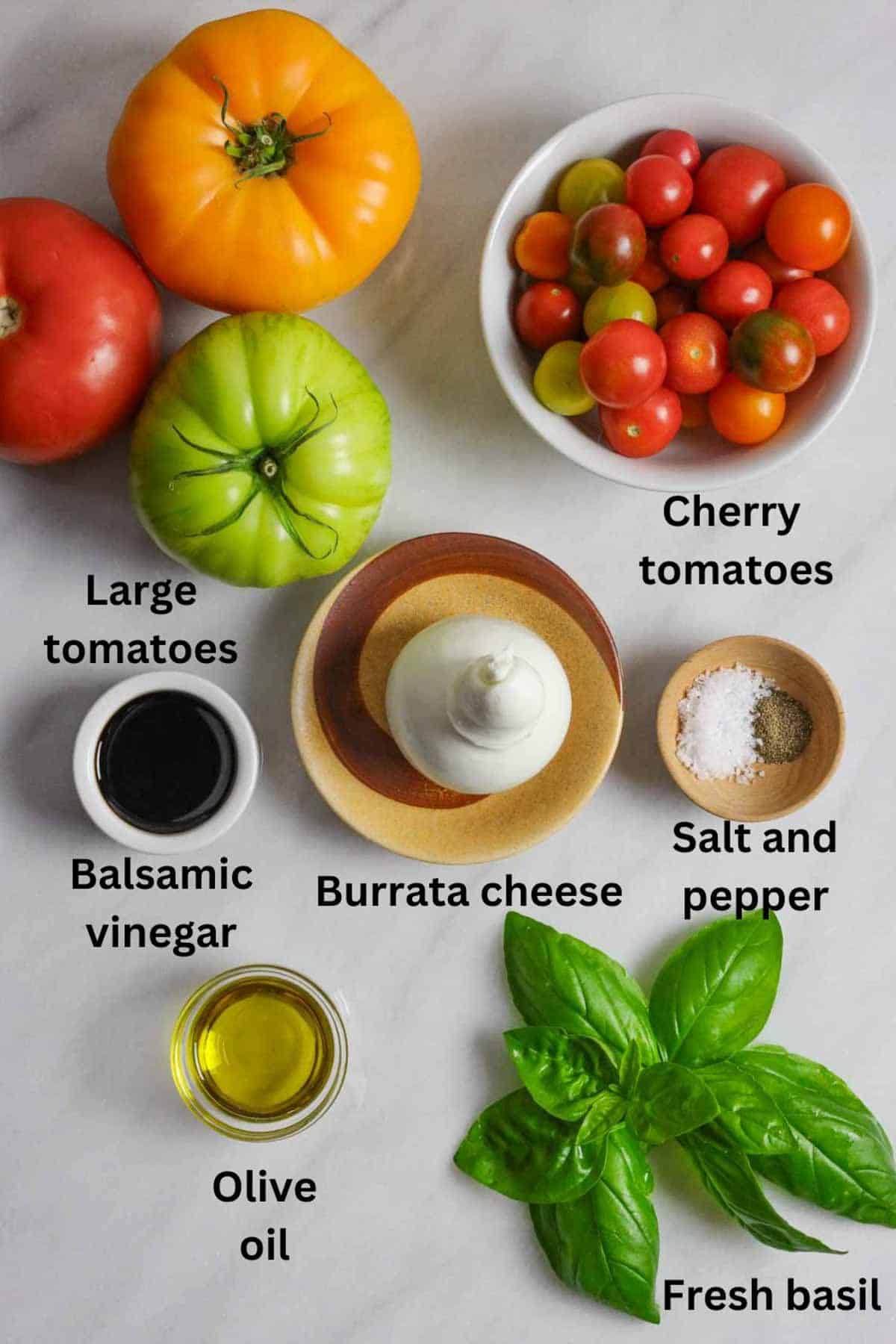
Ingredients
- Burrata cheese – can often be found with mozzarella and other gourmet cheeses in the refrigerated section. Balls will vary in size. Several small balls may be packed together in a container and large balls are usually sold individually.
- Tomatoes – you can use any type or size of tomatoes you like. I used three medium-sized heirlooms and cherry tomatoes to add more color and texture.
- Basil – definitely use fresh
- Olive oil – the higher the quality, the better the flavor
- Balsamic reduction or balsamic vinegar (optional) – balsamic isn’t necessary for a great a caprese, but it adds extra sweetness and complexity. See below for how to make a quick and easy balsamic reduction.
- Salt and pepper – I like to use flake salt and freshly cracked pepper, but you can use what you have on hand
Instructions
Making this salad requires just a few easy steps.
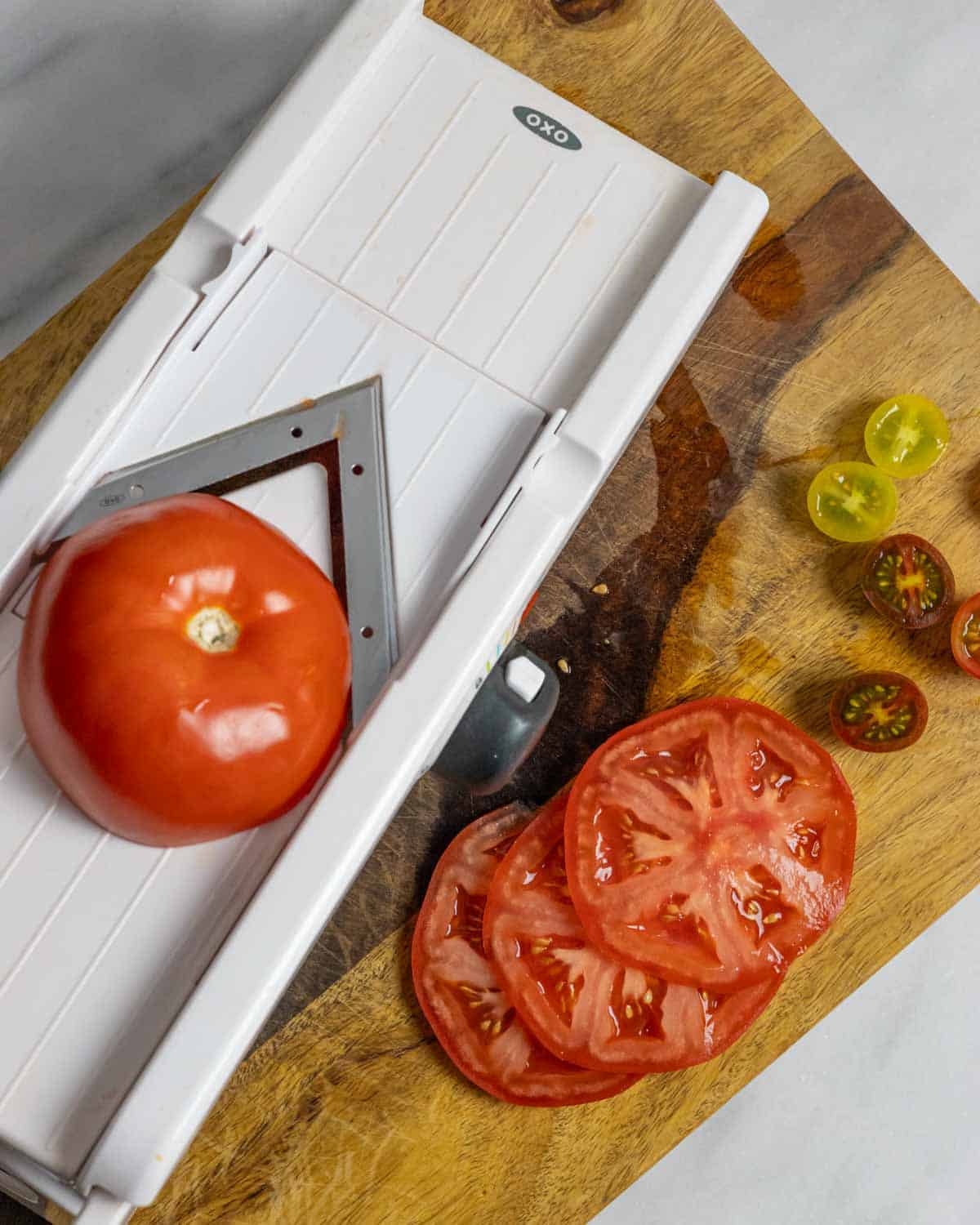
- Wash and dry the tomatoes to remove any debris
- Slice the large tomatoes to desired thickness. I like to use a mandolin for this.
- Cut the cherry tomatoes in half
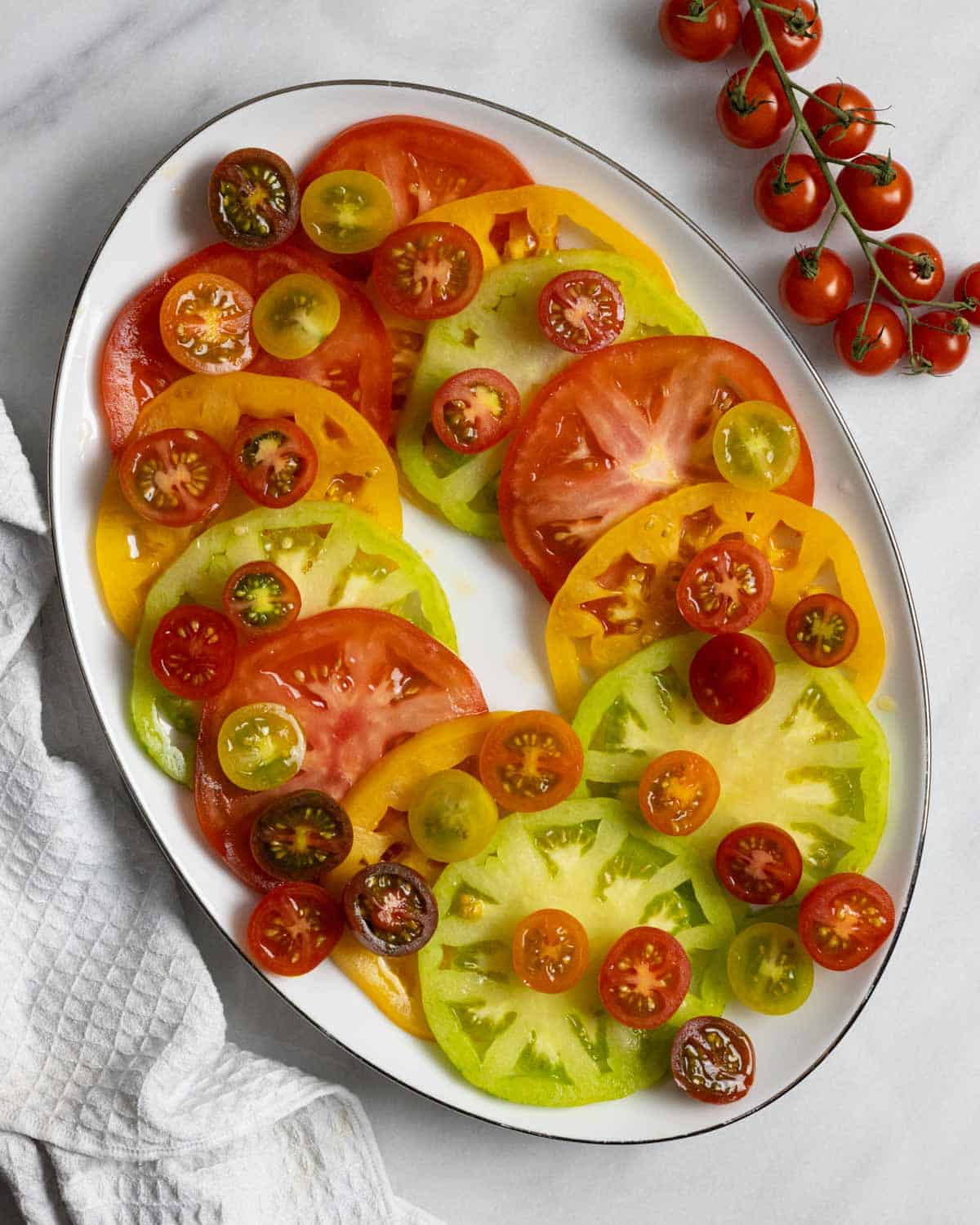
Arrange half of the sliced tomatoes on a plate, leaving a small space in the center for the burrata ball.
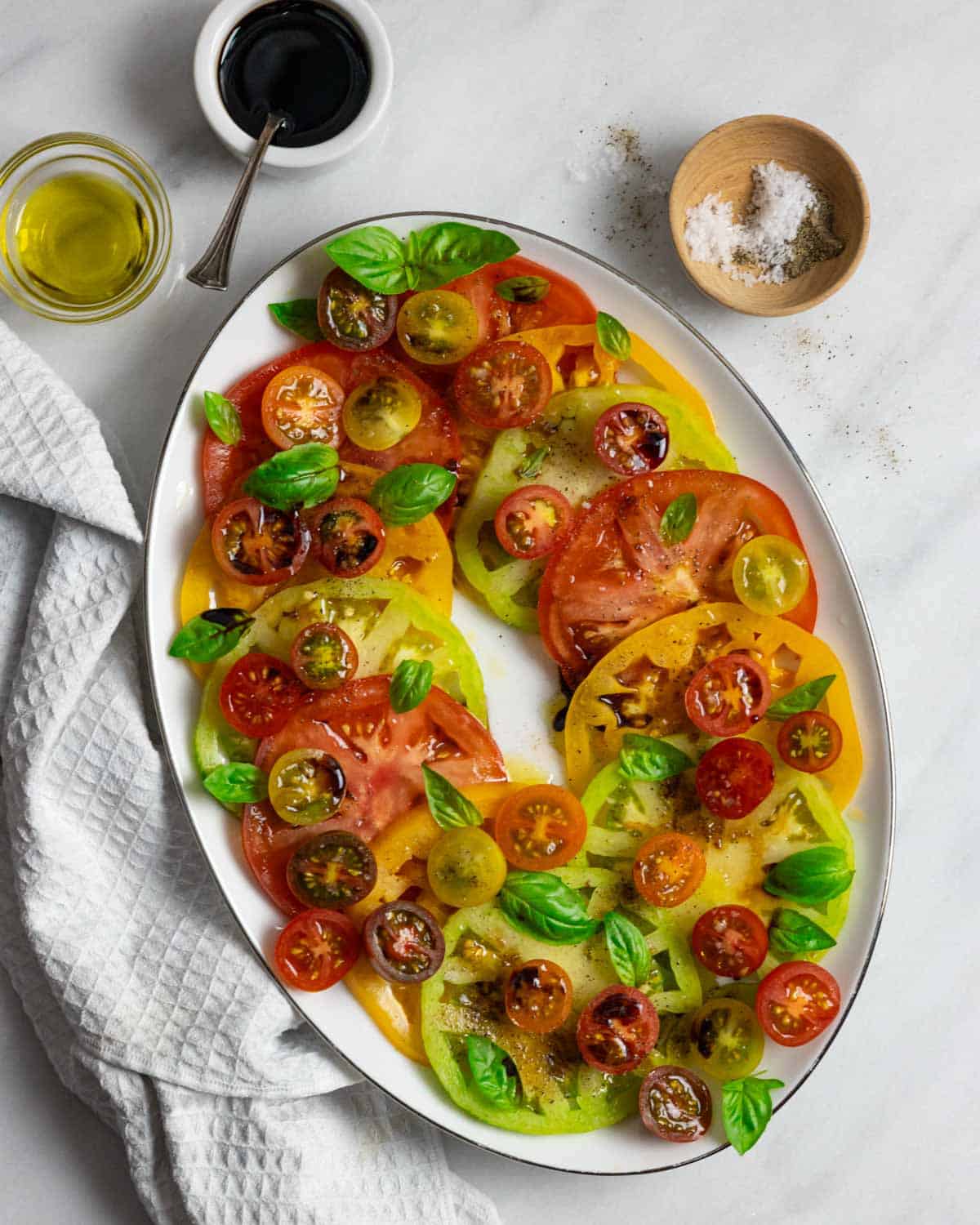
- Top with half the basil leaves, tucking some of the larger leaves between the tomatoes
- Drizzle with olive oil, balsamic (if using) and lightly sprinkle with half the flake salt and pepper

Add the burrata to the center of the plate and place the remaining tomatoes and basil around the cheese. Top with an additional drizzle of olive oil and balsamic and a few more pinches of salt and pepper.
How to make a balsamic reduction
While this is optional, I love the sweetness and tang of balsamic vinegar. Making a reduction (or balsamic glaze) is very fast and easy and I love how it pours over the tomatoes.
- Add ½ cup of balsamic vinegar to a small saucepan and simmer over medium-low heat until it reaches a gentle simmer
- Reduce heat to low and simmer for about 8 minutes, until slightly thickened
- Let cool and serve. Keep in mind that it will continue to thicken as it cools.
Expert tips
- Slice the tomatoes a little bit thick. This will help them keep their shape and retain their juices
- Layering the basil, olive oil, balsamic, salt and pepper ensures even flavor in the salad
- Remove the burrata from the refrigerator about 30 minutes before serving, if possible. This allows the creamy center to soften.
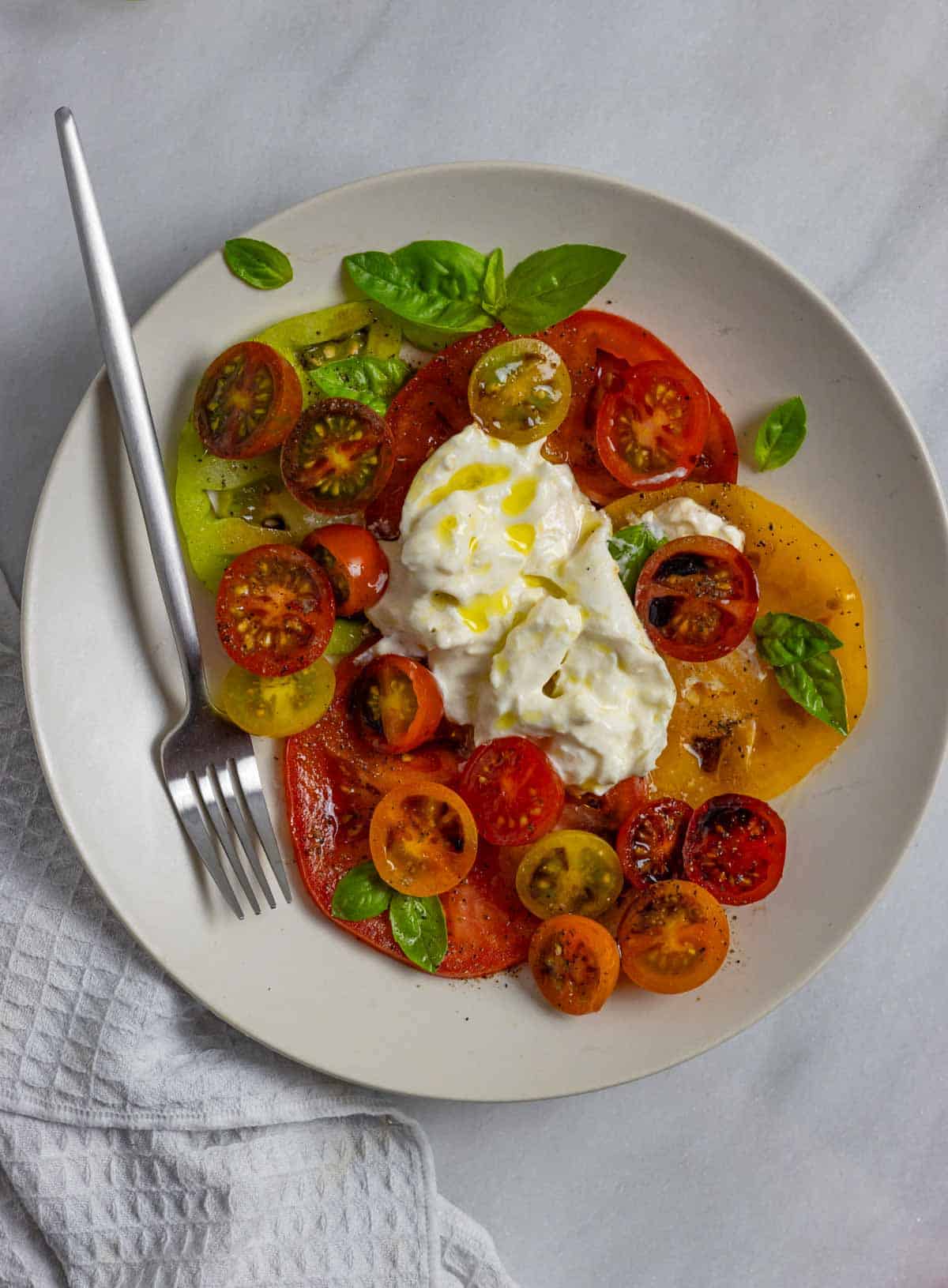
Burrata cheese substitute
If you are making a caprese but don't happen to have burrata and can't find it, there are a few good options for a burrata substitute.
- Ricotta cheese – is creamy, with a similar texture as burrata's soft interior. However, it has more of a tangy flavor, with less of a silky texture.
- Regular mozzarella – while you won't get to enjoy the bliss of burrata's soft center, fresh mozzarella is the closest alternative in regards to flavor. Slice large balls or use small mini-mozzarella balls.
- Chevre or soft goat cheese – while it has a different flavor profile and is often a little stronger in flavor, making a tomato salad with goat cheese is a culinary delight in itself
- Cashew cheese – or other non-dairy cheese. Making a dairy-free caprese is simple. Just swap the burrata for your favorite plant-based cheese. This is a great option to make a paleo, vegan or Whole30 salad.
How to serve
My favorite way to serve this dish is as a burrata caprese salad platter – simply serve on a large plate, with additional sides of olive oil, balsamic, salt and pepper for guests to add extra dressings to their salad plate.
This is a very versatile salad and can be enjoyed as an appetizer, side dish or as a light main course when paired with your favorite protein. See my ideas in the Variations section, below.
How to store
While this dish is best served fresh, leftovers can be stored in the refrigerator in a sealed container for 1-2 days.
Variations
There are so many ways to customize this salad. Here are a few of my favorite variations:
- Add fruit – figs, peaches, avocado and berries are delightful additions. Be sure to pay attention to portion size of figs and peaches for low-carb and low-FODMAP servings.
- Include additional salad ingredients – sliced red or green onion, nuts and seeds are wonderful with tomato salad
- Make carprese salad with pesto – add a drizzle of Homemade Pesto
- Serve on a bed of greens – fresh arugula, spinach and baby lettuce add color and texture
- Add more herbs – replace the basil or add in fresh dill, oregano, thyme or chives
- Make it hearty – add your favorite protein to make a light lunch or dinner salad. My favorites are smoked or grilled salmon, Indian Spiced Salmon, Smoked Flank Steak or slices of Smoked Sirloin and sautéed chicken breast. And, crisp bacon crumbles are always good!
- Vegan caprese – make it dairy-free, paleo and Whole30-friendly by replacing the burrata with your favorite plant-based cheese
FAQ
Yes – even though it’s high in fat and calories, it’s very low in carbohydrates, and high in protein and calcium. Burrata can be enjoyed in small quantities, even for those aiming to lose weight and is a healthy source of fat for a low-carb keto diet. It’s also very low in lactose and is often well-tolerated for those with lactose intolerance.
Yes – this classic salad is very low in carbohydrates and high in healthy fats, making it a delightful addition to a keto diet.
Yes – mozzarella is very low in lactose and can be enjoyed on a low-FODMAP diet. According to the Monash app, ¼ cup serving (about 1.45 ounces) is considered a low-FODMAP serving size.
Yes – all varieties can be enjoyed on a low-FODMAP diet, but fructose concentrations vary. Cherry tomatoes are FODMAP-friendly in small servings of 5 whole tomatoes. Large tomatoes contain less fructose. A serving of ½ a medium tomato (up to about 2.3 ounces) is low in fructose, but becomes moderate in FODMAPs at about 2.6 ounces.
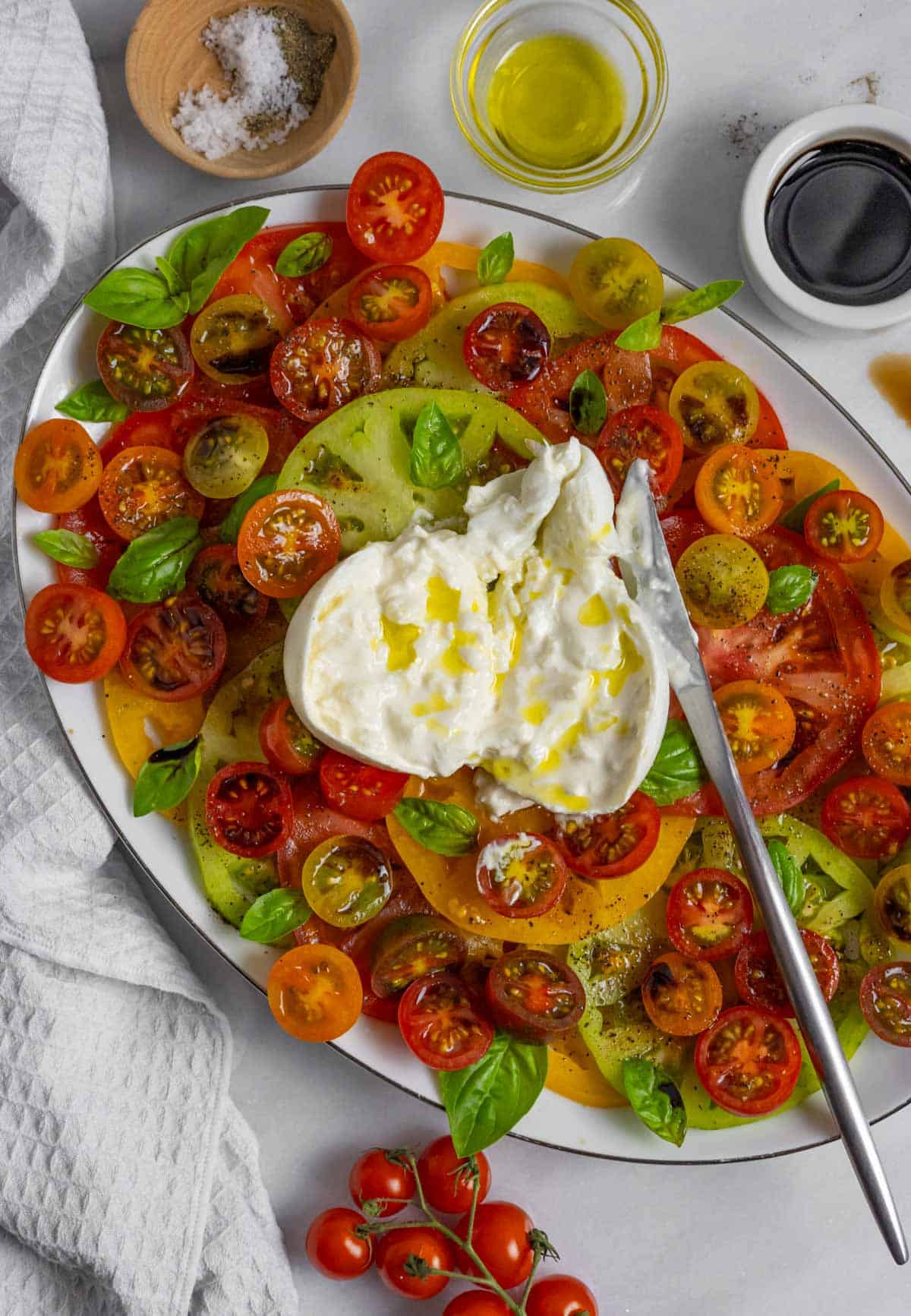
What to serve with burrata caprese
Did you make this recipe? Let me know how you liked it by giving a star rating and leaving a comment!
📖 Recipe
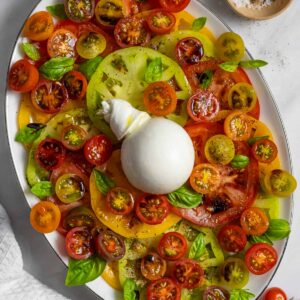
Burrata Caprese
Ingredients
- 3 medium tomatoes (heirloom and vine-ripened are best)
- ½ pound cherry tomatoes
- 1 burrata ball (1 large, about 8 ounces, or two small. Use plant-based cheese for vegan, paleo or Whole30)
- ½ ounce basil leaves (about 15-20 leaves)
- 3 tablespoons olive oil (high quality extra virgin)
- ½ teaspoon salt (flake salt is best)
- ¼ teaspoon black pepper (freshly ground is best)
- balsamic vinegar or balsamic reduction - optional (see Notes)
Instructions
- Wash and dry the tomatoes to remove any debris.
- Slice the large tomatoes to desired thickness. I like to use a mandolin for this. Cut the cherry tomatoes in half.
- Arrange the slices and half the cherry tomatoes on a plate, leaving a small space in the center for the burrata ball.
- Top with half the basil leaves, tucking some of the larger leaves between the tomatoes.
- Drizzle with olive oil, balsamic (if using) and lightly sprinkle with half the flake salt and pepper.
- Add the burrata to the center of the plate and place the remaining tomatoes and basil on the plate. Top with an additional drizzle of olive oil and balsamic and the remaining salt and pepper.
Notes
Expert tips
- Slice the tomatoes a little bit thick. This will help them keep their shape and retain their juices.
- Layering the basil, olive oil, balsamic, salt and pepper ensures even flavor in the salad
- Remove the burrata from the refrigerator about 30 minutes before serving, if possible. This allows the creamy center to soften.
How to make a balsamic reduction
While this is optional, I love the sweetness and tang of balsamic vinegar. Making a reduction (or balsamic glaze) is very fast and easy and I love how it pours over the tomatoes.- Add ½ cup of balsamic vinegar to a small saucepan and simmer over medium-low heat until it reaches a gentle simmer
- Reduce heat to low and simmer for about 8 minutes, until slightly thickened
- Let cool and serve. Keep in mind that it will continue to thicken as it cools.
How to serve
My favorite way to serve this dish is as a burrata caprese salad platter – simply serve on a large plate, with additional sides of olive oil, balsamic, salt and pepper for guests to add extra dressings to their salad plate. This is a very versatile salad and can be enjoyed as an appetizer, side dish or as a light main course when paired with your favorite protein.How to store
While this dish is best served fresh, leftovers can be stored in the refrigerator in a sealed container for 1-2 days.Nutrition
*Net carbs = carbohydrates - fiber
Nutritional information is an estimate, calculated using online tools and does not include optional ingredients unless otherwise indicated.

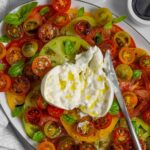
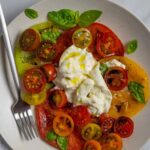

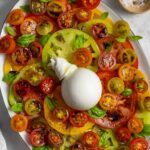

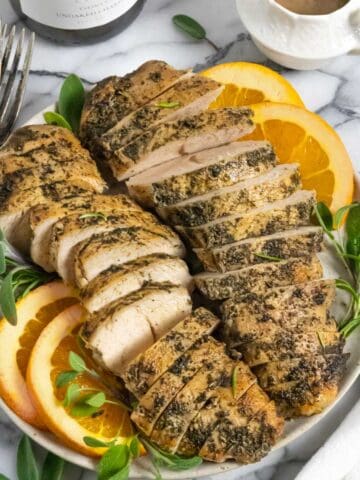
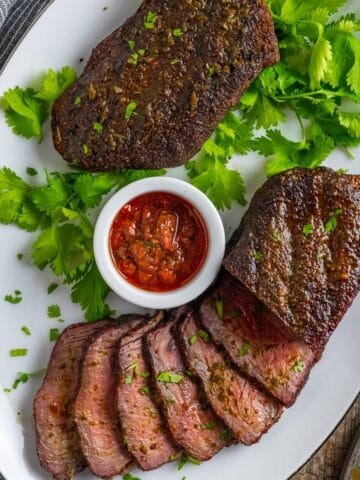
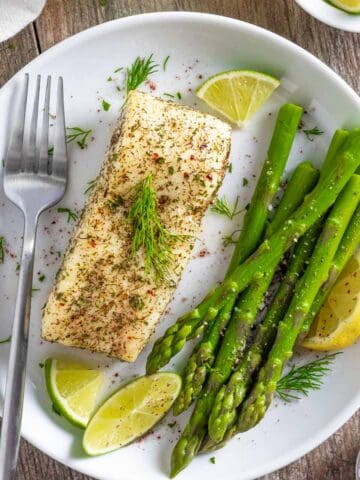
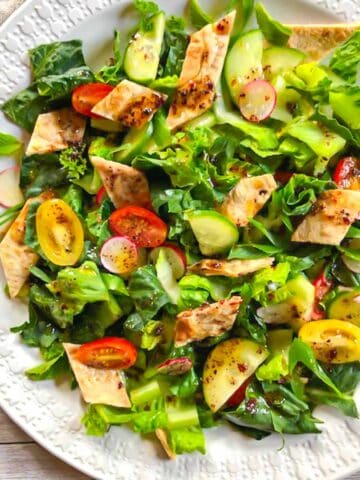
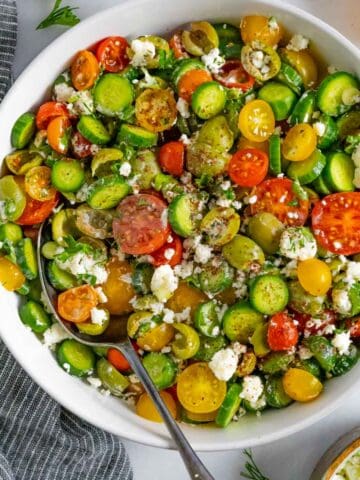
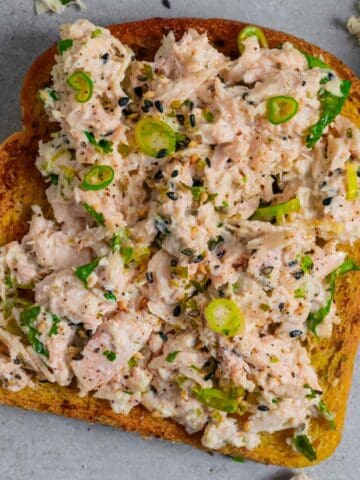
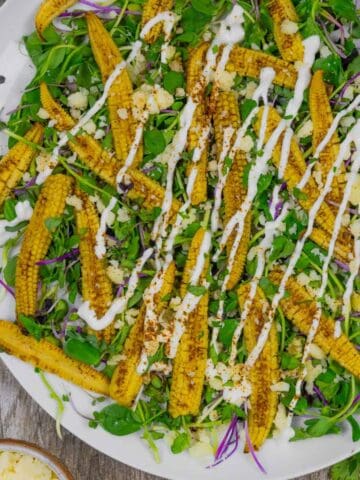
Comments
No Comments